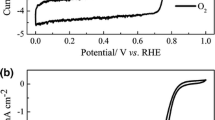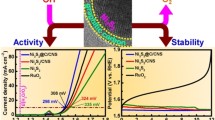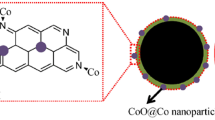Abstract
Nitrogen-doped Fe-based carbon electrocatalyst (Fe–N–C) is developed by a one-pot pyrolysis method, using a solid-state Fe-EDTA coordination complex. The synthesized catalyst was analytically evaluated by various physical and electrochemical measurements. The effect of various synthetic parameters such as sucrose and EDTA and the effect of metal contents were systematically evaluated. The synthesized Fe–N–C shows significant oxygen reduction activity with half-wave potential of 0.81 V, closer to the commercial Pt/C catalyst, with a nearly 3.9 e− transferred per oxygen molecule. The developed catalyst also shows admirable stability under repeated potential cycling conditions, when compared to the Pt/C catalyst. In a single-cell fuel cell performance analysis, the Fe–N–C catalyst exhibited a peak power density of 118 mW cm−2. Moreover, the Fe–N–C showed remarkable durability during the accelerated stress test (AST) at highly corrosive conditions.







Similar content being viewed by others
References
Shao M, Chang Q, Dodelet JP, Chenitz R (2016) Recent advances in electrocatalysts for oxygen reduction reaction. Chem Rev 116:3594–3657
Borup R, Meyers J, Pivovar B, Kim YS, Mukundan R, Garland N, Myers D, Wilson M, Garzon F, Wood D (2007) Scientific aspects of polymer electrolyte fuel cell durability and degradation. Chem Rev 107:3904–3951
Hickner MA (2010) Ion-containing polymers: new energy & clean water. Mater Today 13:34–41
Zhang H, Shen PK (2012) Recent development of polymer electrolyte membranes for fuel cells. Chem Rev 112:2780–2832
Brocq ML, Job N, Eskenazi D, Pireaux JJ (2014) Pt/C catalyst for PEM fuel cells: control of Pt nanoparticles characteristics through a novel plasma deposition method. Appl Catal B 147:453–463
Peera SG, Lee TG, Sahu AK (2019) Pt-rare earth metal alloy/metal oxide catalysts for oxygen reduction and alcohol oxidation reactions: an overview. Sustain. Energy Fuel 3:1866–1891
Shi J, Zhou X, Xu P, Qiao J, Chen Z, Liu Y (2014) Nitrogen and sulfur co-doped mesoporous carbon materials as highly efficient electrocatalysts for oxygen reduction reaction. Electrochim Acta 145:259–269
Wang DW, Su D (2014) Heterogeneous nanocarbon materials for oxygen reduction reaction. Energy Environ Sci 7:576–591
Lee S, Choun M, Ye Y, Lee J, Mun Y, Kang E, Hwang J, Lee YH, Shin CH, Moon SH, Kim SK, Lee E, Lee J (2015) Designing a highly active metal-free oxygen reduction catalyst in membrane electrode assemblies for alkaline fuel cells: effects of pore size and doping-site position. Angew Chem Int Ed 54:9230–9234
Yi M, Hua Y, Wang K, Wang Y, Song S, Tsiakaras P (2018) Enhancement of oxygen reduction reaction performance: the characteristic role of FeN coordinations. Electrochim Acta 260:264–273
Ferrero GA, Diez N, Sevilla M, Fuertes AB (2019) Iron/nitrogen co-doped mesoporous carbon synthesized by an endo-templating approach as an efficient electrocatalyst for the oxygen reduction reaction. Microporous Mesoporous Mater 278:280–288
Yan Z, Dai C, Zhang M, Lv X, Zhao X, Xie J (2019) Nitrogen doped porous carbon with iron promotion for oxygen reduction reaction in alkaline and acidic media. Int J Hydrog Energy 44:4090–4101
Liu Y, Fan YS, Liu ZM (2019) Pyrolysis of iron phthalocyanine on activated carbon as highly efficient non-noble metal oxygen reduction catalyst in microbial fuel cells. Chem Eng 361:416–427
Peera SG, Hyuk-Jun K, Tae GL, Mohammed HA (2020) Heteroatom- and metalloid-doped carbon catalysts for oxygen reduction reaction: a mini-review. Ionics 26:1563–1589
Peers SG, Hyuk-Jun K, Lee TG (2020) Highly efficient Co@NCS nanosheet electrocatalyst for oxygen reduction reaction: an environment-friendly, low-cost and sustainable electrocatalyst. Mater Res Bull 128:110873–110885
Zhang P, Chen C, Zhang X, Jiang Z, Huang J, Chen J (2019) Fe and S co-doped N-enriched hierarchical porous carbon polyhedron as efficient non-noble-metal electrocatalyst toward oxygen reduction reaction in both alkaline and acidic medium. Electrochim Acta 298:570–579
Li T, Deng H, Liu J, Jin C, Song Y, Wang F (2019) First-row transition metals and nitrogen co-doped carbon nanotubes: the exact origin of the enhanced activity for oxygen reduction reaction. Carbon 143:859–868
Li Y, Li Z, Wu Y, Wu H, Zhang H, Wu T, Yuan C, Xu Y, Zeng B, Dai L (2019) Carbon particles co-doped with N, B and Fe from metal-organic supramolecular polymers for boosted oxygen reduction performance. J Power Sources 412:623–630
Lu Y, Jiang Y, Chen W (2013) PtPd porous nanorods with enhanced electrocatalytic activity and durability for oxygen reduction reaction. Nano Energy 2:836–844
Liu Z, Lin X, Lee J, Zhang W, Han M, Gan L (2002) Preparation and characterization of platinum-based electrocatalysts on multiwalled carbon nanotubes for proton exchange membrane fuel cells. Langmuir 18:4054–4060
Sun M, Davenport D, Liu H, Qu J, Elimelech M, Li J (2018) Highly efficient and sustainable non-precious-metal Fe-N-C electrocatalysts for the oxygen reduction reaction. J Mater Chem A 6:2527–2539
Brock SL, Duan N, Tian ZR, Giraldo O, Zhou H, Suib SL (1998) A review of porous manganese oxide materials. Chem Mater 10:2619–2628
Jiang WJ, Gu L, Li L, Zhang Y, Zhang X, Zhang LJ, Wang JQ, Hu JS, Wei Z, Wan LJ (2016) Understanding the high activity of Fe-N-C electrocatalysts in oxygen reduction: Fe/Fe3C nanoparticles boost the activity of Fe-Nx. J Am Chem Soc 138:3570–3578
Jia Q, Ramaswamy N, Hafiz H, Tylus U, Strickland K, Wu G, Barbiellini B, Bansil A, Holby EF, Zelenay P, Mukerjee S (2015) Experimental observation of redox-induced Fe-N switching behavior as a determinant role for oxygen reduction activity. ACS Nano 9:12496–12505
Zitolo A, Goellner V, Armel V, Sougrati MT, Mineva T, Stievano L, Fonda E, Jaouen F (2015) Identification of catalytic sites for oxygen reduction in iron-and nitrogen-doped graphene materials. Nat Mater 14:937–942
Wu G, More K, Johnston C, Zelenay P (2011) High-performance electrocatalysts for oxygen reduction derived from polyaniline, iron and cobalt. Science 332:443–447
Tian Y, Xu L, Qian J, Bao J, Yan C, Li H, Li H, Zhang S (2019) Fe3C/Fe2O3 heterostructure embedded in N-doped graphene as a bifunctional catalyst for quasi-solid-state zinc-air batteries. Carbon 146:763–771
Peera SG, Arunchander A, Sahu AK (2016) Cumulative effect of transition metals on nitrogen and fluorine co-doped graphite nanofibers: an efficient and highly durable non-precious metal catalyst for the oxygen reduction reaction. Nanoscale 8:14650–14664
Zhang X, Huang Y, Chen X, Gao Q, Zhang W (2018) Nitrogen-doped carbon nanotubes based on melamine-formaldehyde resin as highly efficient catalyst for oxygen reduction reaction. J Colloid Interface Sci 509:1–9
Xu J, Wu C, Yu Q, Zhao Y, Li X, Guan L (2018) Antioil Ag3PO4 nanoparticle/polydopamine/Al2O3 sandwich structure for complex wastewater treatment: dynamic catalysis under natural light. ACS Sustain Chem Eng 6:551–560
Niu W, Li L, Liu X, Wang N, Liu J, Zhou W, Tang Z, Chen S (2015) Mesoporous N-doped carbons prepared with thermally removable nanoparticle templates: an efficient electrocatalyst for oxygen reduction reaction. J Am Chem Soc 137:5555–5562
Bashyam R, Zelenay P (2010) A class of non-precious metal composite catalysts for fuel cells. Nature 443:63–66
Öztürk A, Yurtcan AB (2018) Synthesis of polypyrrole (PPy) based porous N-doped carbon nanotubes (N-CNTs) as catalyst support for PEM fuel cells. Int J Hydrog Energy 43:18559–18571
Han SW, Bang J, Ko SH, Ryoo R (2019) Variation of nitrogen species in zeolite-templated carbon by low-temperature carbonization of pyrrole and the effect on oxygen reduction activity. J Mater Chem A 7:8353–8360
Cao S, Han N, Han J, Hu Y, Fan L, Zhou C, Guo R (2016) Mesoporous hybrid shells of carbonized polyaniline/Mn2O3 as non-precious efficient oxygen reduction reaction catalyst. ACS Appl Mater Interfaces 8:6040–6050
Ratso S, Kruusenberg I, Vikkisk M, Joost U, Shulga E, Kink I, Kallio T, Tammeveski K (2014) Highly active nitrogen-doped few-layer graphene/carbon nanotube composite electrocatalyst for oxygen reduction reaction in alkaline media. Carbon 73:361–370
Hossen MM, Artyushkova K, Atanassov P, Serov A (2018) Synthesis and characterization of high performing Fe-N-C catalyst for oxygen reduction reaction (ORR) in alkaline exchange membrane fuel cells. J Power Sources 375:214–222
Guo Z, Zhang Z, Li Z, Dou M, Wang F (2019) Well-defined gradient Fe/Zn bimetal organic framework cylinders derived highly efficient iron- and nitrogen-codoped hierarchically porous carbon electrocatalysts towards oxygen reduction. Nano Energy 57:108–117
Peera SG, Balamurugan J, Kim NH, Lee JH (2018) Sustainable synthesis of CO@NC core shell nanostructures from metal organic frameworks via mechanochemical coordination self-assembly: an efficient electrocatalyst for oxygen reduction reaction. Small 14:1800441–1800456
Wang K, Wang Y, Tong Y, Pan Z, Song S (2016) A robust versatile hybrid electrocatalyst for the oxygen reduction reaction. ACS Appl Mater Interfaces 8:29356–29364
Hua Y, Jiang T, Wang K, Wu M, Song S, Wang Y, Tsiakaras P (2016) Efficient Pt-free electrocatalyst for oxygen reduction reaction: highly ordered mesoporous N and S co-doped carbon with saccharin as single-source molecular precursor. Appl Catal B Environ 194:202–208
Wang C, Yang F, Qiu T, Cao Y, Zhong H, Yu C, Li R, Mao L, Li Y (2018) Preparation of an efficient Fe/N/C electrocatalyst and its application for oxygen reduction reaction in alkaline media. J Electroanal Chem 810:62–68
Sarkar IJR, Peera SG, Chetty R (2018) Manganese oxide nanoparticles supported nitrogen-doped graphene: a durable alkaline oxygen reduction electrocatalyst. J Appl Electrochem 48:849–865
Liu J, Wang L, Sun X, Zhu X (2010) Cerium vanadate nanorod arrays from ionic chelator-mediated self-assembly. Angew Chem Int Ed 49:3492–3495
Kramm UI, Lefèvre M, Larouche N, Schmeisser D, Dodelet JP (2014) Correlations between mass activity and physicochemical properties of Fe/N/C catalysts for the ORR in PEM fuel cell via 57Fe Mössbauer spectroscopy and other techniques. J Am Chem Soc 136:978–985
Chen J, Gao J, Wang X (2006) Thermal decomposition of ethylenediaminetetraacetic acid in the presence of 1,2-phenylenediamine and hydrochloric acid. J Braz Chem Soc 17:880–885
Venezky DL, Rudzinski WE (1984) Determination of ethylenediaminetetraacetic acid in boiler water by liquid chromatography. Anal Chem 56:317–319
Huang X, Schmucker A, Dyke J, Hall SM, Retrum J, Stein B, Remmes N, Baxter DV, Dragneaa B, Bronstein LM (2009) Magnetic nanoparticles with functional silanes: evolution of well-defined shells from anhydride containing silane. J Mater Chem 19:4231–4239
Guo J, Lan M, Wang S, He Y, Zhang S, Xiang G, Boi FS (2015) Enhanced saturation magnetization in buckypaper-films of thin walled carbon nanostructures filled with Fe3C, FeCo, FeNi, CoNi, Co and Ni crystals: the key role of Cl. Phys Chem Chem Phys 17:18159–18166
Xiao M, Zhu J, Feng L, Liu C, Xing W (2015) Meso/macroporous nitrogen-doped carbon architectures with iron carbide encapsulated in graphitic layers as an efficient and robust catalyst for the oxygen reduction reaction in both acidic and alkaline solutions. Adv Mater 27:2521–2527
Zhang LS, Liang XQ, Song WG, Wu ZY (2010) Identification of the nitrogen species on N-doped graphene layers and Pt/NG composite catalyst for direct methanol fuel cell. Phys Chem Chem Phys 12:12055–12059
Chambrion P, Suzuki T, Zhang ZG, Kyotani T, Tomita A (1997) XPS of nitrogen-containing functional groups formed during the C-NO reaction. Energy Fuel 11:681–685
Wu G, Zelenay P (2013) Nanostructured nonprecious metal catalysts for oxygen reduction reaction. Acc Chem Res 46:1878–1889
Bag S, Roy K, Gopinath CS, Raj CR (2014) Facile single-step synthesis of nitrogen-doped reduced graphene oxide-mn3o4 hybrid functional material for the electrocatalytic reduction of oxygen. ACS Appl Mater Interfaces 6:2692–2699
Chetty R, Kundu S, Xia W, Bron M, Schuhmann W, Chirila V, Brandl W, Reinecke T, Muhler M (2009) PtRu nanoparticles supported on nitrogen-doped multiwalled carbon nanotubes as catalyst for methanol electrooxidation. Electrochim Acta 54:4208–4215
Peng H, Liu F, Liu X, Liao S, You C, Tian X, Nan H, Luo F, Song H, Fu Z, Huang P (2014) Effect of transition metals on the structure and performance of the doped carbon catalysts derived from polyaniline and melamine for ORR application. ACS Catal 4:3797–3805
Yuan K, Sfaelou S, Qiu M, Lützenkirchen-Hecht D, Zhuang X, Chen Y, Yuan C, Feng X, Scherf U (2018) Synergetic contribution of boron and Fe-Nx species in porous carbons toward efficient electrocatalysts for oxygen reduction reaction. ACS Energy Lett 3:252–260
Marcus P, Grimal JM (1992) The anodic dissolution and passivation of NiCrFe alloys studied by ESCA. Corros Sci 33:805–814
Siriwardane RV, Cook JM (1985) Interactions of SO2 with sodium deposited on silica. J Colloid Interface Sci 108:414–422
Mills P, Sullivan JL (1983) A study of the core level electrons in iron and its three oxides by means of X-ray photoelectron spectroscopy. J Phys D Appl Phys 16:723–732
Li Z, Chen H, Bao H, Gao M (2004) One-pot reaction to synthesize water-soluble magnetite nanocrystals. Chem Mater 16:1391–1393
Peng H, Mo Z, Liao S, Liang H, Yang L, Luo F, Song H, Zhong Y, Zhang B (2013) High performance Fe- and N- doped carbon catalyst with graphene structure for oxygen reduction. Sci Rep 3:1765–1772
Eissa AA, Peera SG, Kim NH, Lee JH (2019) g-C3N4 templated synthesis of the Fe3C@NSC electrocatalyst enriched with Fe–Nx active sites for efficient oxygen reduction reaction. J Mater Chem A 7:16920–16936
Gong KP, Du F, Xia ZH, Durstock M, Dai LM (2009) Nitrogen-doped carbon nanotube arrays with high electrocatalytic activity for oxygen reduction. Science 323:760–764
Ganesan S, Leonard N, Barton SC (2014) Impact of transition metal on nitrogen retention and activity of iron–nitrogen–carbon oxygen reduction catalysts. Phys Chem Chem Phys 16:4576–4585
Tian LL, Yang J, Weng MY, Tan R, Zheng JX, Chen HB, Zhuang QC, Dai LM, Pan F (2017) Fast diffusion of O2 on nitrogen-doped graphene to enhance oxygen reduction and its application for high-rate Zn-air batteries. ACS Appl Mater Interfaces 9:7125–7130
Wu J, Ma L, Yadav RM, Yang Y, Zhang X, Vajtai R, Lou J, Ajayan PM (2015) Nitrogen-doped graphene with pyridinic dominance as a highly active and stable electrocatalyst for oxygen reduction. ACS Appl Mater Interfaces 7:14763–14769
Ratso S, Kruusenberg I, Sarapuu A, Rauwel P, Saar R, Joost U, Aruvali J, Kanninen P, Kallio T, Tammeveski K (2016) Enhanced oxygen reduction reaction activity of iron-containing nitrogen-doped carbon nanotubes for alkaline direct methanol fuel cell application. J Power Sources 332:129–138
Jin Z, Li P, Xiao D (2014) Enhanced electrocatalytic performance for oxygen reduction via active interfaces of layer-by-layered titanium nitride/titanium carbonitride structures. Sci Rep 4:6712–6719
Li X, Popov BN, Kawahara T, Yanagi H (2011) Non-precious metal catalysts synthesized from precursors of carbon, nitrogen, and transition metal for oxygen reduction in alkaline fuel cells. J Power Sources 196:1717–1722
Gasteiger HA, Kocha SS, Sompalli B, Wagner FT (2005) Activity benchmarks and requirements for Pt, Pt-alloy, and non-Pt oxygen reduction catalysts for PEMFCs. Appl Catal B 56:9–35
Lefèvre M, Proietti E, Jaouen F, Dodelet JP (2009) Iron-based catalysts with improved oxygen reduction activity in polymer electrolyte fuel cells. Science 324:71–74
Sun W, Hsu A, Chen R (2011) Carbon supported tetragonal MnOOH catalysts for oxygen reduction reaction in alkaline media. J Power Sources 196:627–635
Peera SG, Arunchander A, Sahu AK (2016) Platinum nanoparticles supported on nitrogen and fluorine co-doped graphite nanofibers as an excellent and durable oxygen reduction catalyst for polymer electrolyte fuel cells. Carbon 107:667–679
Reiser CA, Bregoli L, Patterson TW, Yi JS, Yang JDL, Perry ML, Jarvi TD (2005) A reverse-current decay mechanism for fuel cells. Electrochem Solid State Lett 8:A273–A276
Knights SD, Colbow KM, St-Pierre J, Wilkinson DP (2004) Aging mechanism and lifetime of PEFC and DMFC. J Power Sources 127:127–134
Zadick A, Dubau L, Sergent N, Berthomé G, Chatenet M (2015) Huge instability of Pt/C catalysts in alkaline medium. ACS Catal 5:4819–4824
Li L, Xing YC (2006) Electrochemical durability of carbon nanotubes in non-catalyzed and catalyzed oxidations. J Electrochem Soc 153:A1823–A1828
Acknowledgments
We would like to thank the Indian Institute of Technology (IIT) Madras for the fellowship to IJRS. We also acknowledge the DST-FIST for providing the instrumentation facility to the Department of Chemical Engineering, IIT Madras.
Funding
RC received funding through Grant No. DST/TMD/HFC/2 K18/34 from the Department of Science and Technology (DST), India.
Author information
Authors and Affiliations
Corresponding author
Additional information
Publisher’s note
Springer Nature remains neutral with regard to jurisdictional claims in published maps and institutional affiliations.
Electronic supplementary material
ESM 1
(DOC 138 kb)
Rights and permissions
About this article
Cite this article
Sarkar, I.J.R., Peera, S.G. & Chetty, R. Fe–N–C catalyst derived from solid-state coordination complex as durable oxygen reduction electrocatalyst in alkaline electrolyte. Ionics 26, 5685–5696 (2020). https://doi.org/10.1007/s11581-020-03722-2
Received:
Revised:
Accepted:
Published:
Issue Date:
DOI: https://doi.org/10.1007/s11581-020-03722-2




